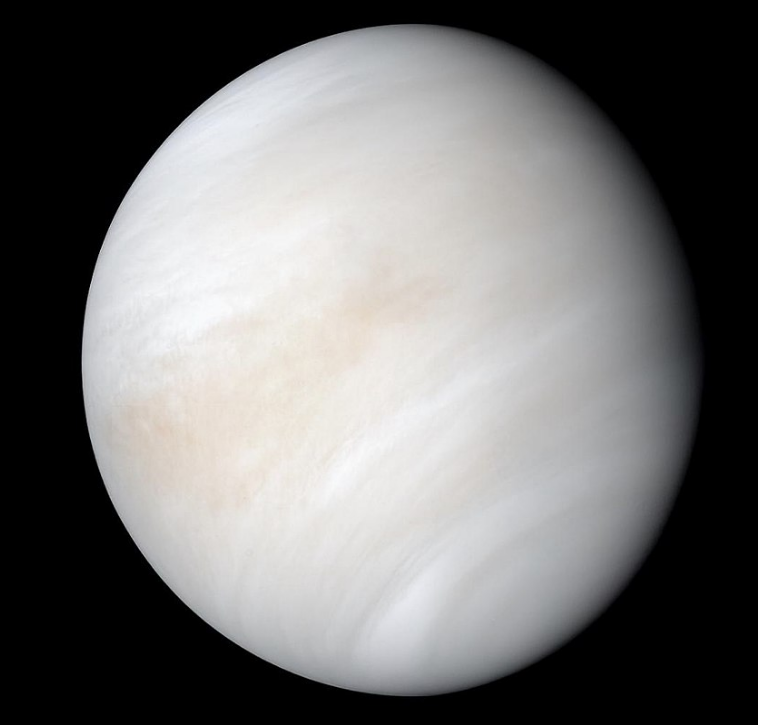NASA launches the rocket from Australia to search for star conditions that support life. That thing means that the "Proxima message" caused some kind of critical thoughts. The BLC 1 (Breakthrough Listen Candidate 1) could be a manmade radio impulse. But the question is again the same with the Wow! signal why it happened only once? If some kind of weather or some other effect causes those signals. That thing should happen more times than once.
The thing why many researchers do not believe. That the origin of the BLC-1 or "Proxima signal" is in Proxima Centauri. Is that Proxima Centauri or Alpha Centauri C is a red dwarf. Those stars are very small. And their planets are locked which means another side of those planets in the habitable zone will be extremely hot. But there is also a Sun-like star in the same direction but 3000 light-years away from us.
Image 2) Venus
Venus is the "sister planet" of Earth. But greenhouse gases are making the surface the hell where the temperature is over 500 degrees celsius. The lowest temperature on planet Venus is -45 degrees celsius. So there could be a very small area where some organisms can live.
One of the reasons for the hellish temperature is that the length of the day of planet Venus is about 243 days. And all that time the sun is shining to the dayside of Venus. So Venus is one example of an almost locked planet that orbits a yellow star. (Wikipedia, Venus)
Image 3) The stellar classification.
There are two types of habitable worlds in the universe.
1) The worlds where life can form and advance. Those planets should orbit yellow spectral class G or maybe the brightest orange spectral class K stars. If the star is between 0,7 and 1,04 solar masses. That thing makes it possible that there are good conditions for the born of life. If it orbits in a habitable zone.
2) The worlds that technically advanced civilizations can colonize. Planets that are orbiting red dwarfs are those planets. The advanced civilizations can dig tunnels under the planet's surface and use the energy that the red dwarf gives.
The fact is that habitable zone. And the existence of liquid water depends on a couple of things. The distance of the planet is a very important thing. But there must be hydrogen and oxygen or some icy comets must bring water to that planet. So there must be also water. And the planet must have a magnetosphere that denies solar wind from destroying those water molecules.
Then the chemical composition of the atmosphere must be right. A large mass of greenhouse gasses can turn the planet into hell. This thing happened on Venus. But a large number of greenhouse gases can make it possible that the liquid water can exist farther from the distance of Earth than we ever thought.
The NASA rocket should assist the JWST telescope to search the planets. That is in the habitable zone of the stars like the Sun. This thing means that there is the possibility that the JWST will find planets that are orbiting red or orange stars in the habitable zone. This time the system will be assisted by multiple smaller satellites and highly advanced artificial intelligence.
https://scitechdaily.com/nasa-rockets-launch-from-australia-to-seek-star-conditions-that-support-extraterrestrial-life/
https://spaceplace.nasa.gov/all-about-venus/en/
https://www.washingtonpost.com/outlook/2020/12/31/breakthrough-listen-seti-technosignatures/
https://en.wikipedia.org/wiki/BLC1
https://en.wikipedia.org/wiki/Proxima_Centauri
https://en.wikipedia.org/wiki/Stellar_classification
https://en.wikipedia.org/wiki/Venus
https://en.wikipedia.org/wiki/Wow!_signal
Image 1) https://scitechdaily.com/nasa-rockets-launch-from-australia-to-seek-star-conditions-that-support-extraterrestrial-life/
Image 2) https://en.wikipedia.org/wiki/Venus
Image 3) https://en.wikipedia.org/wiki/Stellar_classification







No comments:
Post a Comment
Note: Only a member of this blog may post a comment.